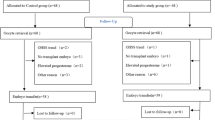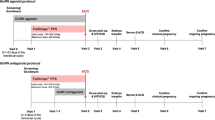Abstract
Use of GnRH antagonists in IVF stimulation protocols shortens controlled ovarian hyperstimulation (COH) and reduces the risk of ovarian hyperstimulation syndrome (OHSS). However, profound reduction in LH levels has been associated with use of GnRH antagonists. This study aims to determine if LH suppression during GnRH antagonist cycles results in poorer IVF outcomes. This was a prospective pilot longitudinal study where serum LH levels were measured on day 2/3 of the menstrual cycle before COH, 1/2 days following institution of GnRH antagonist and at the day of ovulation trigger. A threshold of LH <0.5 IU/L was used to define profound LH suppression. Data on IVF outcomes was collected. Logistic regression analysis was used to investigate risk factors associated with LH suppression following GnRH antagonist IVF treatment. Ninety-one eligible women were recruited. Women underwent a standard antagonist cycle with Puregon 200u and Ganirelix. No participant had LH <0.5 IU/L prior to GnRH antagonist treatment, and 27 participants (29.7%) had significant LH suppression at either time point. Predictors of profound LH suppression following GnRH antagonist treatment identified (P < 0.20) were age (OR = 0.80, P = 0.013), no previous ovulation induction (OR = 0.26, P = 0.033) and previous GnRH antagonist IVF cycle (OR = 4.32, P = 0.125). Numbers of oocytes, embryos and ongoing pregnancy rates at 12 weeks gestation in patients with and without LH suppression did not differ significantly. We found associations between clinical characteristics and risk of profound LH suppression in women undergoing GnRH antagonist IVF cycles, but no significant differences in IVF and pregnancy outcomes between women with and without significant LH suppression.


Similar content being viewed by others
Data Availability
The data are not publicly available due to confidentiality and ethical restrictions.
References
Al-Inany HG, Youssef MA, Ayeleke RO, Brown J, Lam WS, Broekmans FJ. Gonadotrophin-releasing hormone antagonists for assisted reproductive technology. Cochrane Database Syst Rev [Internet]. 2016;(4). Available from: https://doi.org/10.1002/14651858.CD001750.pub4
Hg A, Mafm Y, Aboulghar M, Fj B, Jg S. Gonadotrophin-releasing hormone antagonists for assisted reproductive technology (Review) Summary of Findings for the Main Comparison. 2016;(5).
M.A Y and FV der V and HGA-I and GG and MHM and IA and SMK and M van W, M.A. Y, F. V der V, H.G. A-I, G. G, M.H. M, et al. Gonadotropin-releasing hormone agonist versus HCG for oocyte triggering in antagonist assisted reproductive technology cycles. Cochrane Database Syst Rev [Internet]. 2011;1(10):CD008046. Available from: https://www.cochranelibrary.com/cdsr/doi/10.1002/14651858.CD008046.pub4/epdf/full
Esposito MA, Barnhart KT, Coutifaris C, Patrizio P. Role of periovulatory luteinizing hormone concentrations during assisted reproductive technology cycles stimulated exclusively with recombinant follicle- stimulating hormone. Fertil Steril. 2001;75(3):519–24.
Merviel P, Antoine JM, Mathieu E, Millot F, Mandelbaum J, Uzan S. Luteinizing hormone concentrations after gonadotropin-releasing hormone antagonist administration do not influence pregnancy rates in in vitro fertilization-embryo transfer. Fertil Steril. 2004;82(1):119–25.
Raju GAR, Chavan R, Deenadayal M, Gunasheela D, Gutgutia R, Haripriya G, et al. Luteinizing hormone and follicle stimulating hormone synergy: a review of role in controlled ovarian hyper-stimulation. J Hum Reprod Sci [Internet]. 2013;6(4):227–34. Available from: https://www.ncbi.nlm.nih.gov/pubmed/24672160
Westergaard LG. Increased risk of early pregnancy loss by profound suppression of luteinizing hormone during ovarian stimulation in normogonadotrophic women undergoing assisted reproduction. Hum Reprod. 2000;15(5):1003–8.
Zhang Q, Yan J, Tang R, Gao X, Zhang B, Chen Z-J. Serum human chorionic gonadotropin level measured 17 days after oocyte retrieval can predict final clinical pregnancy outcomes in IVF/ICSI treatment cycles. J Reprod Med. 2014;59(5–6):285–92.
Fleming R, Rehka P, Deshpande N, Jamieson ME, Yates RWS, Lyall H. Suppression of LH during ovarian stimulation: effects differ in cycles stimulated with purified urinary FSH and recombinant FSH. Hum Reprod. 2000;15(7):1440–5.
Chappel SC, Howles C. Reevaluation of the roles of luteinizing hormone and follicle-stimulating hormone in the ovulatory process. Hum Reprod [Internet]. 1991;6(9):1206–12. Available from: http://www.ncbi.nlm.nih.gov/pubmed/1752920
Kolibianakis EM, Tarlatzis B, Devroey P. GnRH antagonists in IVF. Reprod Biomed Online [Internet]. 2005;10(6):705–12. Available from: https://doi.org/10.1016/S1472-6483(10)61113-3
Ramachandran A, Jamdade K, Kumar P, Kumar Adiga S, Bhat RG, Ferrao SR. Is there a need for luteinizing hormone (LH) estimation in patients undergoing ovarian stimulation with gonadotropin-releasing hormone antagonists and recombinant follicle-stimulating hormone? J Clin Diagn Res. 2014;8(1):90–2.
Hill MJ, Levy G, Levens ED. Does exogenous LH in ovarian stimulation improve assisted reproduction success? An appraisal of the literature. Reprod Biomed Online [Internet]. 2012;24(3):261–71. Available from: https://doi.org/10.1016/j.rbmo.2011.12.005
Griesinger G, Shapiro DB, Kolibianakis EM, Witjes H, Mannaerts BM. No association between endogenous LH and pregnancy in a GnRH antagonist protocol: part II, recombinant FSH. Reprod Biomed Online [Internet]. 2011;23(4):457–65. Available from: https://doi.org/10.1016/j.rbmo.2011.06.016
The ganirelix dose-finding study group. A double-blind, randomized, dose-finding study to assess the efficacy of the gonadotrophin-releasing hormone antagonist ganirelix (Org 37462) to prevent premature luteinizing hormone surges in women undergoing ovarian stimulation with recombinant follicle. Hum Reprod. 1998;13(11):3023–31.
Roeca C, Johnson RL, Truong T, Carlson NE, Polotsky AJ. Birth outcomes are superior after transfer of fresh versus frozen embryos for donor oocyte recipients. Hum Reprod [Internet]. 2020 Dec 1;35(12):2850–9. Available from: https://doi.org/10.1093/humrep/deaa245
Code Availability
Not applicable.
Funding
This study was funded by the SingHealth-Duke-NUS Obstetrics and Gynaecology Academic Clinical Program Research Grant.
Author information
Authors and Affiliations
Corresponding authors
Ethics declarations
Ethics Approval and Consent to Participate
This study was conducted in accordance with the ethics standards stated in the Declaration of Helsinki and was reviewed and approved by the SingHealth Centralised Institutional Review Board for ethics approval. Written informed consent was obtained from all participants.
Conflict of Interest
The authors declare no competing interests.
Additional information
Publisher’s Note
Springer Nature remains neutral with regard to jurisdictional claims in published maps and institutional affiliations.
Rights and permissions
About this article
Cite this article
Goh, J.P., Lee, J.C.S., Chan, J.K.Y. et al. The Effect of Luteinising Hormone Suppression in In Vitro Fertilisation Antagonist Cycles. Reprod. Sci. 28, 3164–3170 (2021). https://doi.org/10.1007/s43032-021-00608-0
Received:
Accepted:
Published:
Issue Date:
DOI: https://doi.org/10.1007/s43032-021-00608-0




